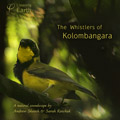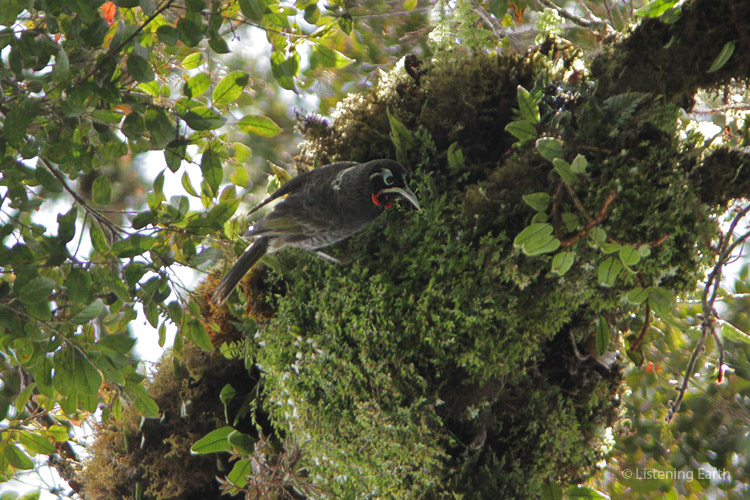

Running Time:
159 min
Release Date:
April 2018
Recording Location:
Camp 13 (scientific camp) at 3000m, reached from Boksavin village, Huon Peninsula, Papua New Guinea
Mossforest - New Guinea
Enter the realm of a New Guinean cloudforest.
Approaching 2800 meters in the Papuan mountains, the upland rainforest habitat transitions to actual cloudforest, which the local people describe as the mossforest.
Both names are very appropriate. The clouds which form at this altitude swirl as mists through the trees. This airborn moisture encourages prolific growth of mosses, and everything is cloaked in a vibrant green; fallen timber on the forest floor and the trunks of living trees, while epiphytic mosses hang from high branches.
Many bird species in these mountains are restricted to altitudinal zones, and those heard here form a community unique to these high elevation forests. In addition, several are endemic to the Huon Peninsula, where this recording was made.
The Huon Melidectes is one of them; a large honeyeater whose loud, rollicking call is a signature sound of this forest. Lesser Melampittas are heard from the understory with their penetrating 'zizzing' calls, a Greater Ground Robin sings a particularly beautiful song, lorikeets skitter overhead, Black-throated and Rufous-backed Honeyeaters are vocal, and the aptly-named Friendly Fantail whistles delicate musical phrases. Meanwhile, moisture accumulating in the canopy overhead drops as dewfall.
This is an unedited recording, made shortly after dawn. Birdong ebbs and flows as they move through the forest pursuing their morning activity. As well as a document of a seldom-visited and unique habitat, this is a relaxing and spacious recording.
Andrew comments:
"This high altitude habitat was a principle destination for the expedition I joined with fellow members of the Australian Wildlife Sound Recording Group to the Huon Peninsula in November of 2017. I've described the expedition itself on our AWSRG website.
"To reach the highest point on the range, we set off from a mid-point campsite at 2700m, first trekking down into a deep valley, then up the other side and higher. As we approached 3000m in the afternoon, the forest gradually changed. We sensed we were entering somewhere special. Maybe it was our footfalls sinking into the soft, mossy layers on the forest floor, or hearing a Huon Melidectes for the first time.
"After establishing our camp, we each set off to explore, listen, and decide where we'd like to record. Both Sue Gould and I felt that a small saddle nearby held prospect of being an interesting site, being somewhat more open and forming a small amphitheatre. She recorded there the first morning, and I the second.
"This recording is from that location. I set up my microphones in the middle of the saddle, just as the dawn chorus was waning. You can hear the last of the Regent Whistler who's territory was close by. At first, I felt there wasn't much going on, but as I atuned to this new place, I began hearing all kinds of interesting calls. I was hearing all these species for the first time.
"I listened with a mixture of excitement, curiosity and natural stillness. I hope that in playing this recording, you can too.
"Few researchers have been to this environment, and as far as we know, this is the first time it has been sound recorded. So you're hearing something special."
Audio sample of this album
|
1. |
End of the Dawn Chorus, with Regent Whistler |
29.19 |
|
2. |
Lesser Melampita & Black-throated Honeyeater |
28.46 |
|
3. |
Song of the Greater Ground Robin |
38.08 |
|
4. |
Black Fantail & Blue-capped Ifrits |
33.53 |
|
5. |
Huon Melidectes |
28.37 |
Purchase this
album as:
Digital Album
(for immediate download)
Download this album
for as little as
$7.50 -
View Special Deals
(Prices AU$, exGST)
Mp3:
Mp3 is a universal audio format, playable on iPods, computers, media players and mobile phones.
Mp3 is a compressed format, allowing smaller filesizes, offering faster download times and requiring less storage space on players, but at some expense to the audio quality. Many listeners can't really hear the difference between mp3 and full CD-quality audio, and hence its convenience has lead to it becoming the default option for audio.
Our albums are generally encoded at around 256kbps (sometimes with VBR), balancing optimal audio quality without blowing out filesizes excessively. We encode using the Fraunhoffer algorithm, which preserves more detail in the human audible range than the lame encoder.
Our mp3 files are free of any DRM (digital rights management), so you can transfer them to any of your media technology. You've paid for them, they're yours for your personal use without restriction.
Mp3 files can be burned to disc, either as an mp3 disc, or an audio CD after converting them to a standard audio (.wav or .aif) format first.
FLAC:
FLAC is a high-quality audio format, allowing CD-resolution audio. It is ideal if you wish to burn your files to a CDR, or listen over a high resolution audio system. However files usually require special decoding by the user before playing or burning to disc.
FLAC (Free Lossless Audio Codec) is a LOSSLESS compressed audio format. This means that it preserves the full audio quality of a CD, but optimises the filesize for downloading. Typically, file sizes of around 60% are achieved without any degradation or loss of audio quality from the source files at the CD standard of 16bit/44.1kHz.
Obviously the file sizes are larger than for the mp3 version - usually around 300-400Mb for an album, compared to 100Mb for an mp3 album.
In addition, you'll need to know what to do with the files once you've downloaded them. In most cases you'll want to decode the files to wav or aiff, either to import into programs like iTunes, or burn to CDR. Some programs will play flac files natively.
There is a lot of information about flac online (eg: http://flac.sourceforge.net/)





 Alternate audio link
Alternate audio link 